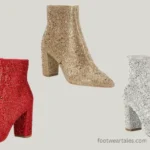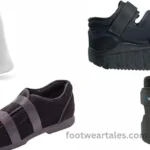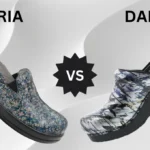How to stop shoes from squeaking is essential knowledge to gain because the experience of the embarrassment that follows the squeaky shoes can be both cringe-worthy and relatable. It’s as if the universe has conspired against you, amplifying the slightest noise to ensure everyone in the room knows your presence. Whether during a solemn meeting, a silent library, or a peaceful classroom, that squeaky shoe has a knack for stealing the spotlight at the wrong moment.
As we journey through squeaky shoes, I’ll uncover the various causes behind this noisy nuisance – from moisture trapped within the soles to friction between different shoe components. Dont worry! I won’t leave you hanging with a list of problems; instead, I’ll provide practical and effective solutions catering to different shoe materials and types. Say goodbye to awkward glances and hello to confident strides.
Let’s first learn the bottom cause of the squeaky shoe before we learn how to stop shoes from squeaking on the floor.
Why do my Shoes Squeak?
Your shoes might be squeaking for the following reasons:
- Your shoes are new
- Wear and Tear of old shoes.
- Trapped air and moisture in the sole
- Your shoes have rubber soles
- The trapped water makes your shoes squeak
- You are wearing shoes without socks
- Shoelaces are making squeak
The reasons mentioned above can cause the shoes to squeak. The squeaking can be in different parts such as shoe insole, outsole, shoe bottom, or shoelace. Before you grab your tools and start tinkering with your sneakers, it’s crucial to consider whether it may impact your shoe warranty.
How to Stop Shoes from Squeaking
Part 1 – For Squeaky Outsoles:
The outsole of a shoe is often the culprit behind this annoying noise, and it can be pretty frustrating to deal with. There are ways to stop the bottom of the shoes from squeaking on the floor.
Rub Outsoles with a Sandpaper
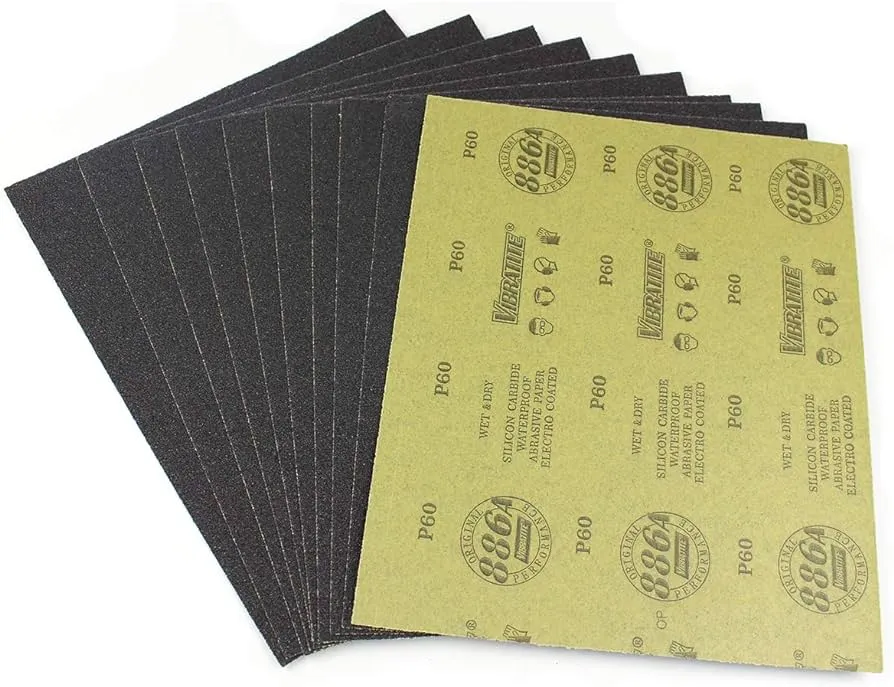
Grab some sandpaper with 120-220 grit and gently rub the outsoles of your shoes to silence that unwanted noise. The sandpaper’s rough texture will help smooth out any irregularities on the outsoles, eliminating the source of the squeaking.
Rubbing outsoles with sandpaper can also revitalize worn-out soles. Over time, wear and Tear can cause outsoles to become uneven and lose traction. By using sandpaper to even out the surface of the outsole, you can improve traction and extend the life of your favorite pair of shoes.
Rub Outsoles with a Dryer Sheet
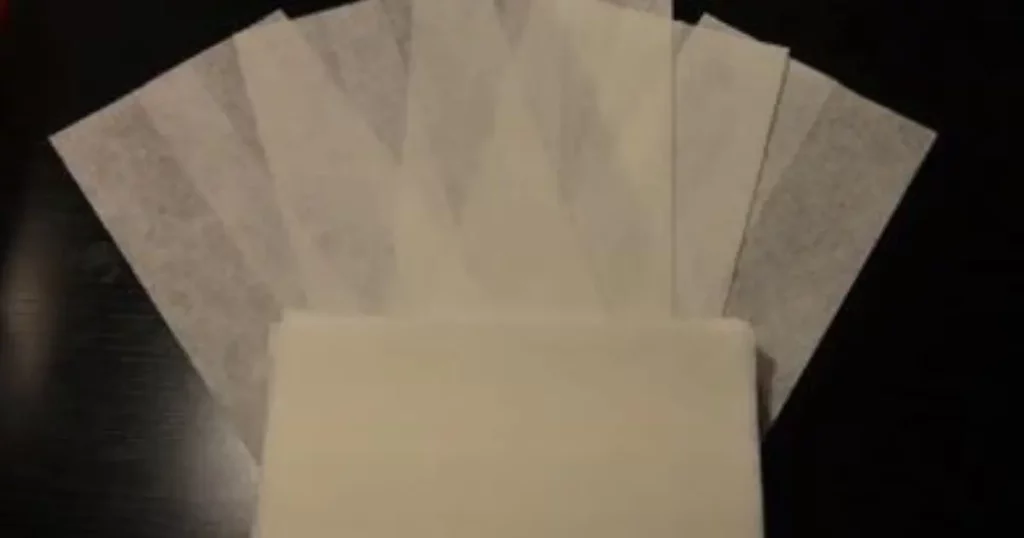
Wondering how to stop shoes from squeaking with dryer sheets? Well, rubbing outsoles with dryer sheets may seem unconventional, but the results are surprisingly effective. Not only do dryer sheets eliminate unpleasant odors from your shoes, but they also leave a subtle, fresh scent behind. The anti-static properties of the dryer sheet help repel dust and dirt, keeping your outsoles cleaner for extended periods.
Using dryer sheets to rub outsoles can be a sustainable alternative to chemical-laden shoe cleaners. By opting for this simple method, you reduce your environmental impact while maintaining your shoes’ cleanliness and hygiene. This approach also extends the lifespan of your footwear by preventing premature wear and Tear caused by accumulated grime on the outsoles.
Spray with a Grip Adhesive

The innovative solution of spraying outsoles with a grip adhesive is a simple yet effective method that provides a quick and easy way to enhance traction on various surfaces, giving you more confidence and stability with every step. Silicone sole sprays, like WD-40, offer a convenient way to apply a thin layer of adhesive that can significantly improve the slip resistance of your footwear.
One of the key benefits of using a silicone sole spray is its versatility. Whether you need better traction for hiking boots, athletic shoes, or even high heels, this method can be applied to virtually any type of footwear.
The application process is hassle-free and requires minimal effort for maximum results. Incorporating this technique into your shoe care routine ensures your favorite pairs remain safe and reliable in various environments. You can reapply the spray when the shoes get squeaky again.
Super Glue your Soles
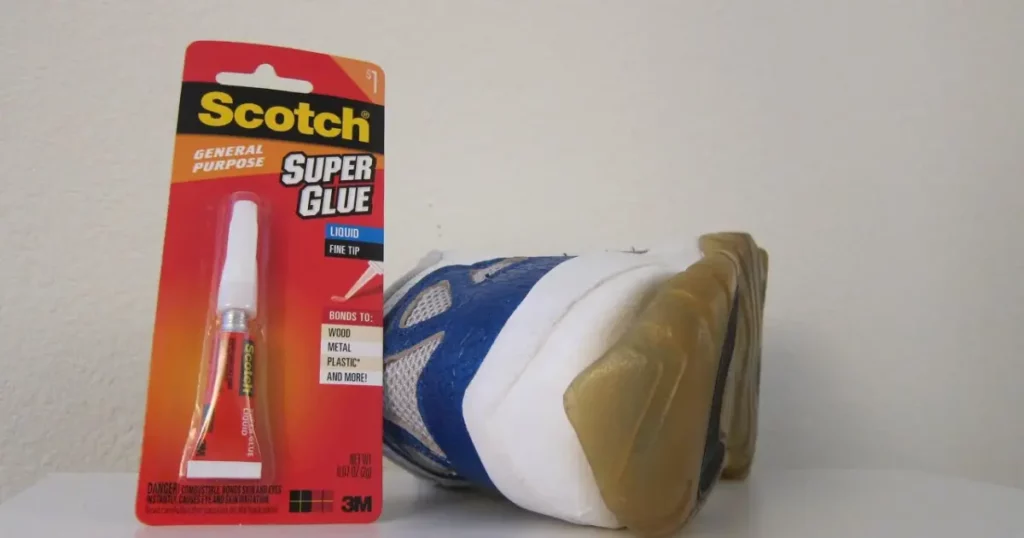
When the sole is partially detached from the bottom of the shoe, it creates an awkward and embarrassing sound. There’s a simple and effective solution for this: super glue. This powerful adhesive can reattach the loose parts of your shoe soles, silencing those pesky squeaks and saving you from embarrassment.
Using super glue to fix squeaky shoes is practical and cost-effective. It allows you to extend the life of your favorite footwear without spending money on professional repairs or replacements.
Part 2 – For Water Damage:
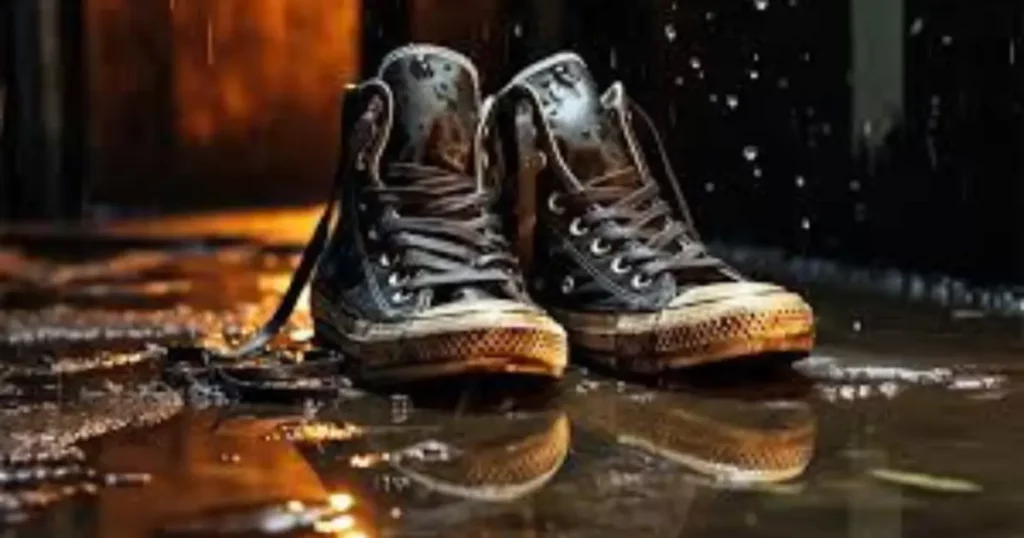
If you’ve ever been caught in the rain or stepped into a puddle, you know the struggle of dealing with wet shoes. Not only can walking around in soggy footwear be uncomfortable, but moist shoes can also lead to an unwelcome side effect: squeaking. The good news is that there are effective ways to air-dry wet shoes and prevent them from making that frustrating noise.
Let your Shoes Dry
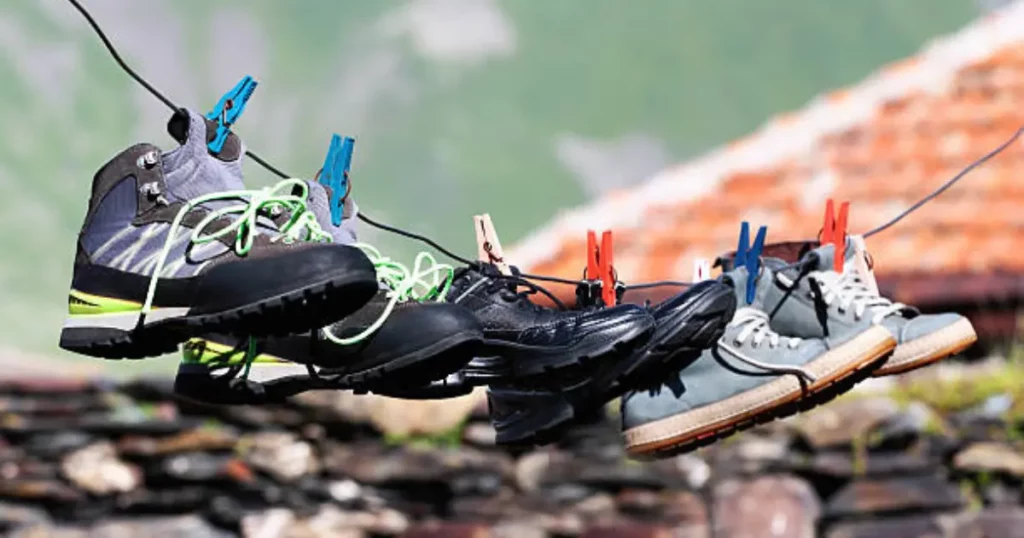
The typical response may be to reach for the hairdryer or place it in direct sunlight; letting your shoe air dry is often the most effective and gentle approach. First, remove any excess water by blotting with a towel or inserting newspaper to absorb moisture from inside the shoes. Next, find a well-ventilated area where they can hang or sit without being disturbed. It’s essential to avoid exposing them to direct heat sources as this can warp certain materials, especially leather, and cause damage in the long run.
Use Baby Powder

Baby powder is amazingly absorbent, making it the perfect solution for drying damp shoes. First, remove the insoles. Sprinkle a generous amount of baby powder into your shoes and let it sit overnight. The powder will work its magic by absorbing moisture, leaving your shoes dry and fresh by morning.
For extra effectiveness, place your powdered shoes in a plastic bag and leave them in the freezer for a few hours to accelerate the drying process.
Put Shoes in the Dryer

Drying shoes in a dryer is the last option, as it can damage the materials and structure of the shoes. However, if you have no choice, there are some tips to ensure you do it correctly.
Start by removing excess dirt or debris from the shoes to avoid damaging the dryer. Then, place the shoes in a mesh laundry bag or tie them with cotton shoelaces to minimize noise and protect the dryer and the shoes.
Setting the tumble dry cycle on low heat or no heat setting is crucial. Excessive heat can cause damage to certain materials like rubber, leather, or synthetic fabrics.
Adding clean towels to balance the load will help absorb moisture and reduce unnecessary tumbling noises during drying. By following these simple steps, you can effectively dry your shoes in a dryer without causing any damage while saving time and effort.
Part 3 – For Squeaky Insoles
If your shoes are making a squeaking sound no matter where you walk, then the reason could be your insoles shifting and rubbing against the inside of your shoes. This movement can create friction, resulting in annoying squeaky noise with each step. Here are some steps you can take to address this issue.
Use a Dryer Sheet

Your laundry room has a solution for your annoying squeaking shoes. Using a dryer sheet to eliminate the squeak from your shoes is a simple yet effective hack that many people swear by. The anti-static properties of dryer sheets help to reduce the friction between your insoles and shoe lining, thus minimizing the annoying noise as you walk.
The process is easy – slip a dryer sheet into your shoes beneath the insoles and let it work magic. Not only will this little trick silence those irritating squeaks, but it will also leave your shoes smelling fresh and clean.
You can also use paper towels if you don’t have dryer sheets and repeat the same process and change them after every few wears.
Sprinkle Baby Powder
Sprinkling baby powder on squeaky insoles is a simple yet effective hack to treat squeaky insoles. It’s also an economical and natural solution. The fine particles of the powder work their way into the crevices of the insole, reducing friction and eliminating those pesky, embarrassing squeaks with every step. This quick fix not only addresses the immediate issue but also helps to keep your feet feeling fresh and dry throughout the day.
Wear Socks
Wearing socks with squeaky insoles may seem simple, but its benefits outweigh the annoying sound. Wearing socks can absorb moisture and keep your feet dry, prolonging the life of your squeaky insoles.
Socks provide cushioning and reduce friction between the insole and your feet, which can help prevent blisters and discomfort during long walks or runs. Socks with Moisture-wicking and breathable materials can improve airflow and keep your feet cool, while padded or cushioned socks offer extra support for sensitive feet.
Use Lubricant Under the Insoles
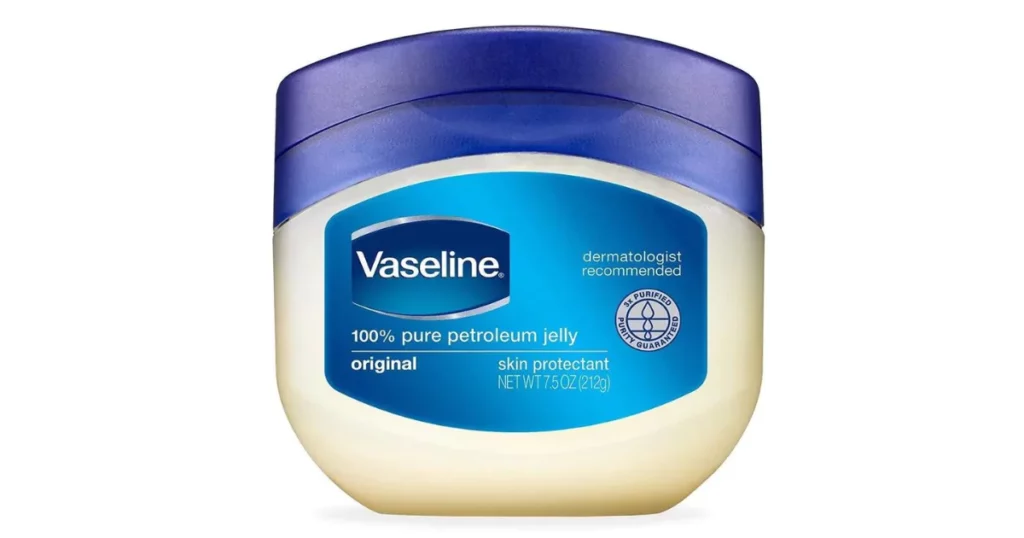
It may sound unconventional, but applying a small amount of lubricant, such as petroleum jelly or coconut oil, under the insoles can significantly reduce unwanted friction and silence those pesky squeaks.
First, ensure your insoles are removable before applying any lubricant. Next, remove the insoles and gently apply a thin layer of lubricant of your choice onto the bottoms of the insoles. Consider using a non-greasy option to avoid making a mess inside your shoes.
This method works effectively and helps prolong your shoes’ lifespan by minimizing wear and Tear caused by constant rubbing.
Part 4 – For Squeaky Shoelaces:
One of the reasons for a squeaky shoe is often friction between the lace and the eyelets of your shoe. This friction generates vibrations, creating the high-pitched squeaking noise we all love to hate. So next time you hear that familiar sound, remember it’s not just in your head – there’s real physics at play.
Rub on Saddle Soap

For unwanted squeaky shoelaces, consider rubbing the shoelace with saddle soap. This simple solution is often overlooked but can work wonders in eliminating the squeakiness.
Saddle soap, commonly used for leather care, provides a smooth and lubricating effect that can reduce friction between the shoelace and the eyelets. By effectively conditioning the lace with saddle soap, you will not only silence that annoying squeak but also prolong the life of your shoelaces.
Part 5 – For Squeaky Heels:
The frustration of hearing your heels coming loose from the shoe as you walk can be enough to ruin an otherwise perfect outfit.
Superglue Your Heels
A small dab of super glue strategically placed on the inner sole where the heel meets the shoe can work wonders in silencing those pesky squeaks. This simple and cost-effective solution not only saves you money from buying new shoes but also prolongs the life of your beloved footwear. Super glue provides a durable bond that keeps your heel secure, preventing further wear and Tear.
Another practical tip is to seek professional shoe repair services to reattach or reinforce the heels of your shoes. This can prolong their lifespan and save you from constantly dealing with squeaky embarrassment.
Final Thoughts on How to Stop Shoes from Squeaking
Dealing with squeaky shoes can be a real nuisance, but with the right strategies, it’s manageable. You can significantly reduce or eliminate the noise by identifying the root cause of the squeaking, such as loose insoles or worn-out soles, and addressing it head-on. Simple remedies like using baby powder, applying lubricants, or consulting a professional cobbler can significantly reduce or completely eradicate the squeaking.
Regular maintenance and care for shoes can prevent your shoes from squeaking. With these practical solutions, individuals no longer need to endure the annoyance of noisy footwear. Take proactive steps today to ensure silent and comfortable strides in every setting.
FAQ’s
Will leather conditioner help with squeaky shoes?
Yes, applying leather conditioners can soften stiff areas and reduce noise caused by friction in leather shoes.
Are certain types of shoes more prone to squeaking than others?
While any shoe can potentially develop a squeak, those made from synthetic materials or ones with multiple layers tend to be more susceptible.
How can I prevent future shoe squeaks?
Regular maintenance, such as keeping them dry, using powders or conditioners as needed, and ensuring they are properly fixed if damaged, can all help prevent future shoe noises.
What kind of insoles are best for preventing shoes from squeaking on tile floors?
Consider using insoles made from low-friction materials like foam or cork to prevent your shoes from making squeaking noises on tile floors.
Can I seek professional help if DIY methods don’t work for me?
Yes. If you cannot fix it yourself, head over to a professional cobbler, who should be able to diagnose and rectify any problems with your footwear.


